
- •Preface
- •About This Book
- •Acknowledgments
- •Contents at a Glance
- •Contents
- •Relaxing at the Beach
- •Dressing the Scene
- •Animating Motion
- •Rendering the Final Animation
- •Summary
- •The Interface Elements
- •Using the Menus
- •Using the Toolbars
- •Using the Viewports
- •Using the Command Panel
- •Using the Lower Interface Bar Controls
- •Interacting with the Interface
- •Getting Help
- •Summary
- •Understanding 3D Space
- •Using the Viewport Navigation Controls
- •Configuring the Viewports
- •Working with Viewport Backgrounds
- •Summary
- •Working with Max Scene Files
- •Setting File Preferences
- •Importing and Exporting
- •Referencing External Objects
- •Using the File Utilities
- •Accessing File Information
- •Summary
- •Customizing Modify and Utility Panel Buttons
- •Working with Custom Interfaces
- •Configuring Paths
- •Selecting System Units
- •Setting Preferences
- •Summary
- •Creating Primitive Objects
- •Exploring the Primitive Object Types
- •Summary
- •Selecting Objects
- •Setting Object Properties
- •Hiding and Freezing Objects
- •Using Layers
- •Summary
- •Cloning Objects
- •Understanding Cloning Options
- •Mirroring Objects
- •Cloning over Time
- •Spacing Cloned Objects
- •Creating Arrays of Objects
- •Summary
- •Working with Groups
- •Building Assemblies
- •Building Links between Objects
- •Displaying Links and Hierarchies
- •Working with Linked Objects
- •Summary
- •Using the Schematic View Window
- •Working with Hierarchies
- •Setting Schematic View Preferences
- •Using List Views
- •Summary
- •Working with the Transformation Tools
- •Using Pivot Points
- •Using the Align Commands
- •Using Grids
- •Using Snap Options
- •Summary
- •Exploring the Modifier Stack
- •Exploring Modifier Types
- •Summary
- •Exploring the Modeling Types
- •Working with Subobjects
- •Modeling Helpers
- •Summary
- •Drawing in 2D
- •Editing Splines
- •Using Spline Modifiers
- •Summary
- •Creating Editable Mesh and Poly Objects
- •Editing Mesh Objects
- •Editing Poly Objects
- •Using Mesh Editing Modifiers
- •Summary
- •Introducing Patch Grids
- •Editing Patches
- •Using Modifiers on Patch Objects
- •Summary
- •Creating NURBS Curves and Surfaces
- •Editing NURBS
- •Working with NURBS
- •Summary
- •Morphing Objects
- •Creating Conform Objects
- •Creating a ShapeMerge Object
- •Creating a Terrain Object
- •Using the Mesher Object
- •Working with BlobMesh Objects
- •Creating a Scatter Object
- •Creating Connect Objects
- •Modeling with Boolean Objects
- •Creating a Loft Object
- •Summary
- •Understanding the Various Particle Systems
- •Creating a Particle System
- •Using the Spray and Snow Particle Systems
- •Using the Super Spray Particle System
- •Using the Blizzard Particle System
- •Using the PArray Particle System
- •Using the PCloud Particle System
- •Using Particle System Maps
- •Controlling Particles with Particle Flow
- •Summary
- •Understanding Material Properties
- •Working with the Material Editor
- •Using the Material/Map Browser
- •Using the Material/Map Navigator
- •Summary
- •Using the Standard Material
- •Using Shading Types
- •Accessing Other Parameters
- •Using External Tools
- •Summary
- •Using Compound Materials
- •Using Raytrace Materials
- •Using the Matte/Shadow Material
- •Using the DirectX 9 Shader
- •Applying Multiple Materials
- •Material Modifiers
- •Summary
- •Understanding Maps
- •Understanding Material Map Types
- •Using the Maps Rollout
- •Using the Map Path Utility
- •Using Map Instances
- •Summary
- •Mapping Modifiers
- •Using the Unwrap UVW modifier
- •Summary
- •Working with Cameras
- •Setting Camera Parameters
- •Summary
- •Using the Camera Tracker Utility
- •Summary
- •Using Multi-Pass Cameras
- •Creating Multi-Pass Camera Effects
- •Summary
- •Understanding the Basics of Lighting
- •Getting to Know the Light Types
- •Creating and Positioning Light Objects
- •Viewing a Scene from a Light
- •Altering Light Parameters
- •Working with Photometric Lights
- •Using the Sunlight and Daylight Systems
- •Using Volume Lights
- •Summary
- •Selecting Advanced Lighting
- •Using Local Advanced Lighting Settings
- •Tutorial: Excluding objects from light tracing
- •Summary
- •Understanding Radiosity
- •Using Local and Global Advanced Lighting Settings
- •Working with Advanced Lighting Materials
- •Using Lighting Analysis
- •Summary
- •Using the Time Controls
- •Working with Keys
- •Using the Track Bar
- •Viewing and Editing Key Values
- •Using the Motion Panel
- •Using Ghosting
- •Animating Objects
- •Working with Previews
- •Wiring Parameters
- •Animation Modifiers
- •Summary
- •Understanding Controller Types
- •Assigning Controllers
- •Setting Default Controllers
- •Examining the Various Controllers
- •Summary
- •Working with Expressions in Spinners
- •Understanding the Expression Controller Interface
- •Understanding Expression Elements
- •Using Expression Controllers
- •Summary
- •Learning the Track View Interface
- •Working with Keys
- •Editing Time
- •Editing Curves
- •Filtering Tracks
- •Working with Controllers
- •Synchronizing to a Sound Track
- •Summary
- •Understanding Your Character
- •Building Bodies
- •Summary
- •Building a Bones System
- •Using the Bone Tools
- •Using the Skin Modifier
- •Summary
- •Creating Characters
- •Working with Characters
- •Using Character Animation Techniques
- •Summary
- •Forward versus Inverse Kinematics
- •Creating an Inverse Kinematics System
- •Using the Various Inverse Kinematics Methods
- •Summary
- •Creating and Binding Space Warps
- •Understanding Space Warp Types
- •Combining Particle Systems with Space Warps
- •Summary
- •Understanding Dynamics
- •Using Dynamic Objects
- •Defining Dynamic Material Properties
- •Using Dynamic Space Warps
- •Using the Dynamics Utility
- •Using the Flex Modifier
- •Summary
- •Using reactor
- •Using reactor Collections
- •Creating reactor Objects
- •Calculating and Previewing a Simulation
- •Constraining Objects
- •reactor Troubleshooting
- •Summary
- •Understanding the Max Renderers
- •Previewing with ActiveShade
- •Render Parameters
- •Rendering Preferences
- •Creating VUE Files
- •Using the Rendered Frame Window
- •Using the RAM Player
- •Reviewing the Render Types
- •Using Command-Line Rendering
- •Creating Panoramic Images
- •Getting Printer Help
- •Creating an Environment
- •Summary
- •Creating Atmospheric Effects
- •Using the Fire Effect
- •Using the Fog Effect
- •Summary
- •Using Render Elements
- •Adding Render Effects
- •Creating Lens Effects
- •Using Other Render Effects
- •Summary
- •Using Raytrace Materials
- •Using a Raytrace Map
- •Enabling mental ray
- •Summary
- •Understanding Network Rendering
- •Network Requirements
- •Setting up a Network Rendering System
- •Starting the Network Rendering System
- •Configuring the Network Manager and Servers
- •Logging Errors
- •Using the Monitor
- •Setting up Batch Rendering
- •Summary
- •Compositing with Photoshop
- •Video Editing with Premiere
- •Video Compositing with After Effects
- •Introducing Combustion
- •Using Other Compositing Solutions
- •Summary
- •Completing Post-Production with the Video Post Interface
- •Working with Sequences
- •Adding and Editing Events
- •Working with Ranges
- •Working with Lens Effects Filters
- •Summary
- •What Is MAXScript?
- •MAXScript Tools
- •Setting MAXScript Preferences
- •Types of Scripts
- •Writing Your Own MAXScripts
- •Learning the Visual MAXScript Editor Interface
- •Laying Out a Rollout
- •Summary
- •Working with Plug-Ins
- •Locating Plug-Ins
- •Summary
- •Low-Res Modeling
- •Using Channels
- •Using Vertex Colors
- •Rendering to a Texture
- •Summary
- •Max and Architecture
- •Using AEC Objects
- •Using Architectural materials
- •Summary
- •Tutorial: Creating Icy Geometry with BlobMesh
- •Tutorial: Using Caustic Photons to Create a Disco Ball
- •Summary
- •mental ray Rendering System
- •Particle Flow
- •reactor 2.0
- •Schematic View
- •BlobMesh
- •Spline and Patch Features
- •Import and Export
- •Shell Modifier
- •Vertex Paint and Channel Info
- •Architectural Primitives and Materials
- •Minor Improvements
- •Choosing an Operating System
- •Hardware Requirements
- •Installing 3ds max 6
- •Authorizing the Software
- •Setting the Display Driver
- •Updating Max
- •Moving Max to Another Computer
- •Using Keyboard Shortcuts
- •Using the Hotkey Map
- •Main Interface Shortcuts
- •Dialog Box Shortcuts
- •Miscellaneous Shortcuts
- •System Requirements
- •Using the CDs with Windows
- •What’s on the CDs
- •Troubleshooting
- •Index
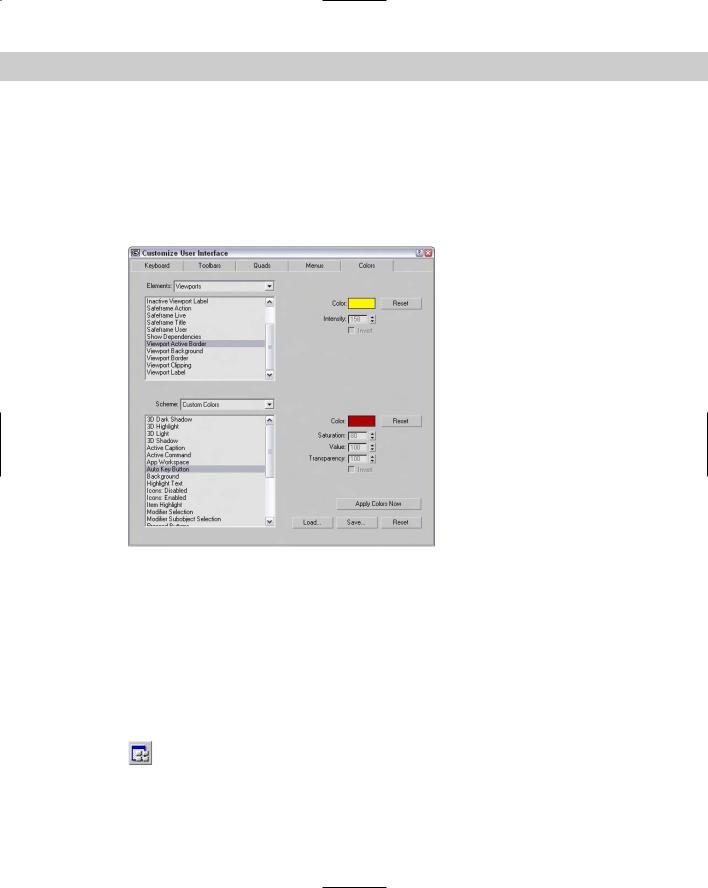
138 Part I Learning the Max Interface
Customizing colors
Within Max, the colors often indicate the mode in which you’re working. For example, red marks animation mode. Using the Colors panel of the Customize User Interface dialog box, you can set custom colors for all Max interface elements. This panel, shown in Figure 4-9, includes two panes. The upper pane displays the available items for the interface selected in the Elements drop-down list. Selecting an item in the list displays its color in the color swatch to the right.
Figure 4-9: You can use the Colors panel of the Customize
User Interface dialog box to set the colors used in the interface.
The lower pane displays a list of the custom colors that can be changed to affect the appearance of the interface. For example, Highlight Text isn’t an element; it’s an interface appearance. The Scheme drop-down list can alter the color scheme between custom colors and the Windows Default Colors.
You can save custom color settings as files with the .clr extension. You can use the Apply Colors Now button to immediately update the interface colors.
Customizing Modify and Utility Panel Buttons
The Modify and the Utilities panels in the Command Panel both include a button called Configure Button Sets that allows you to configure how the modifiers are grouped and
which utility buttons appear in the Utilities panel.
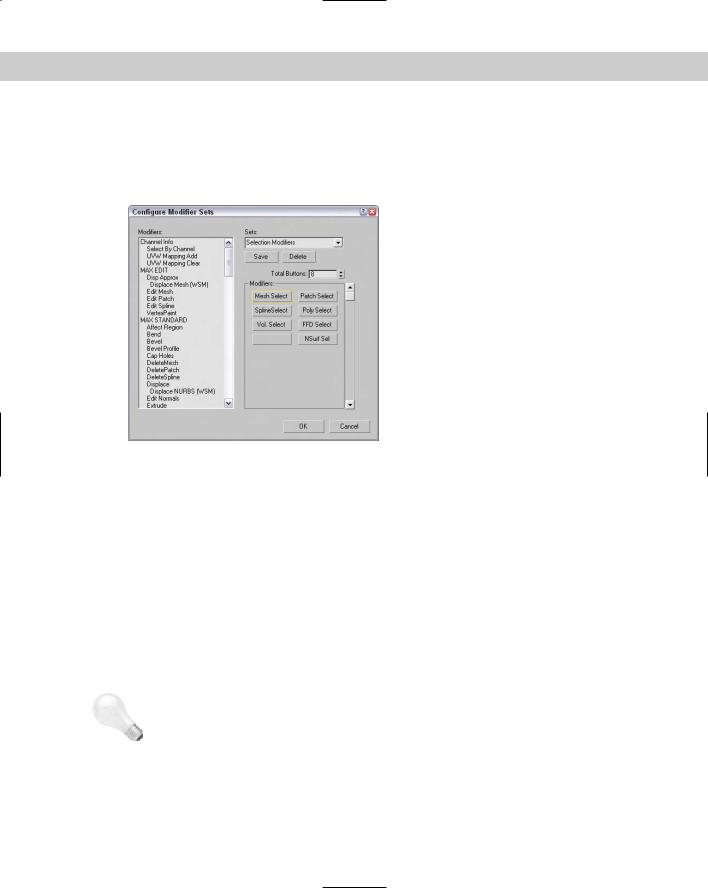
Chapter 4 Customizing the Max Interface and Setting Preferences |
139 |
In the Modify panel, the Configure Modifier Sets button is the right-most button directly under the Modifier Stack. This button opens a pop-up menu that lists all the modifier categories. The top pop-up menu command is Configure Modifier Sets, which opens a dialog box, shown in Figure 4-10, when selected. Using this dialog box, you can control which modifiers are grouped with which sets.
Figure 4-10: The Configure Modifier Sets dialog box lets you group the modifiers as you want.
To add a modifier to a set, select the set from the Sets drop-down list and drag the modifier from the list of Modifiers on the left to the button set on the right. To create a new set, simply type a new name into the Sets field. After a set has changed, you need to save it with the Save button.
You can find the same Configure Button Sets button on the Utilities panel. Clicking this button opens a similar dialog box where you can drag from a list of Utilities onto a list of buttons on the right. These buttons are then displayed in the Utilities panel.
Working with Custom Interfaces
If you’ve changed your interface, you’ll be happy to know that the Customize menu includes a way for you to save and then reload your custom setup. This feature is especially helpful for users who share a copy of Max.
Tip Any custom .ui file can be loaded as the default interface from the command line by adding a –c and the .ui filename after the 3dsmax.exe file (for example, 3dsmax.exe –c my_interface.ui).
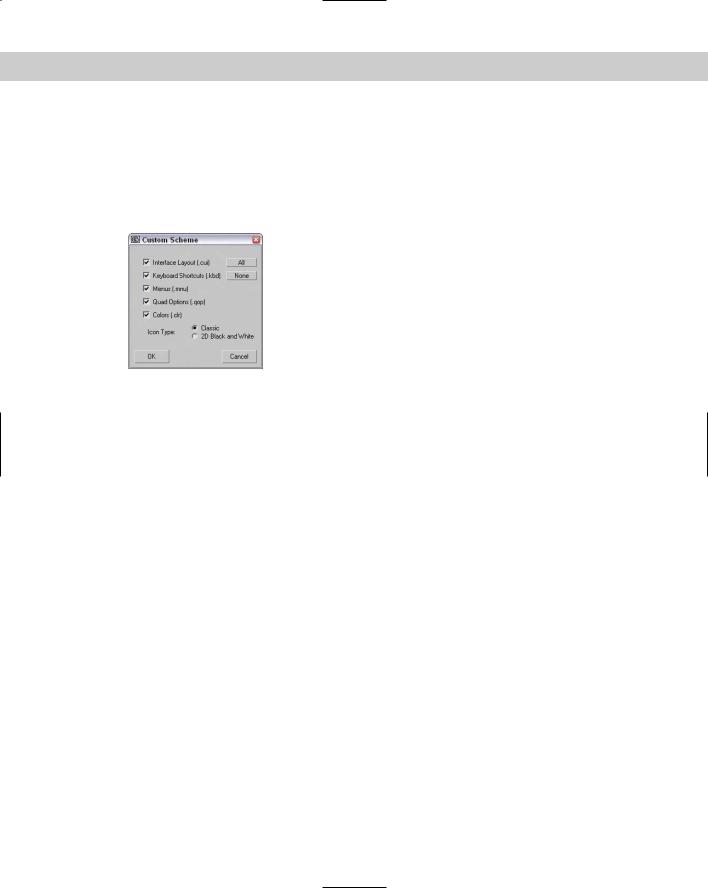
140 Part I Learning the Max Interface
Saving and loading a custom interface
Custom interface schemes are saved with the .ui extension using the Customize Save Custom UI Scheme menu command. When you save a custom scheme, Max opens a Custom Scheme dialog box, shown in Figure 4-11. This dialog box lets you choose which customizations to include in the custom scheme. It also lets you select the icon type to use. The options are Classic and 2D Black and White.
Figure 4-11: The Custom Scheme dialog box appears when you’re saving a custom interface and lets you select which items to include.
You can load saved user interface schemes with Customize Load Custom UI. The default Max install includes several predefined interface setups that are located in the UI directory. The standard available interfaces include
DefaultUI: Default interface that opens when Max is first installed.
Discreet-dark: Displays the standard interface with black windows, backgrounds, and viewports. All the icons and menus are light gray and many of the icons are different.
Discreet-light: Same as the Discreet-dark layout, except the icons and menus are black and the backgrounds are all light gray. Many icons are different here, too.
ModularToolbarsUI: An interface that breaks the main toolbar into many different smaller toolbars that are easier to move and arrange.
Figure 4-12 shows the Discreet-dark custom interface. If you’re one who likes to wear sunglasses, this interface might feel just right to you.
You can use both the load and save menu commands to save and load any of the custom user interface files types including these:
Interface Scheme files (.ui)
UI files (.cui)
Menu files (.mnu)
Color files (.clr)
Keyboard Shortcut files (.kbd)
Quadmenu Options files (.qop)
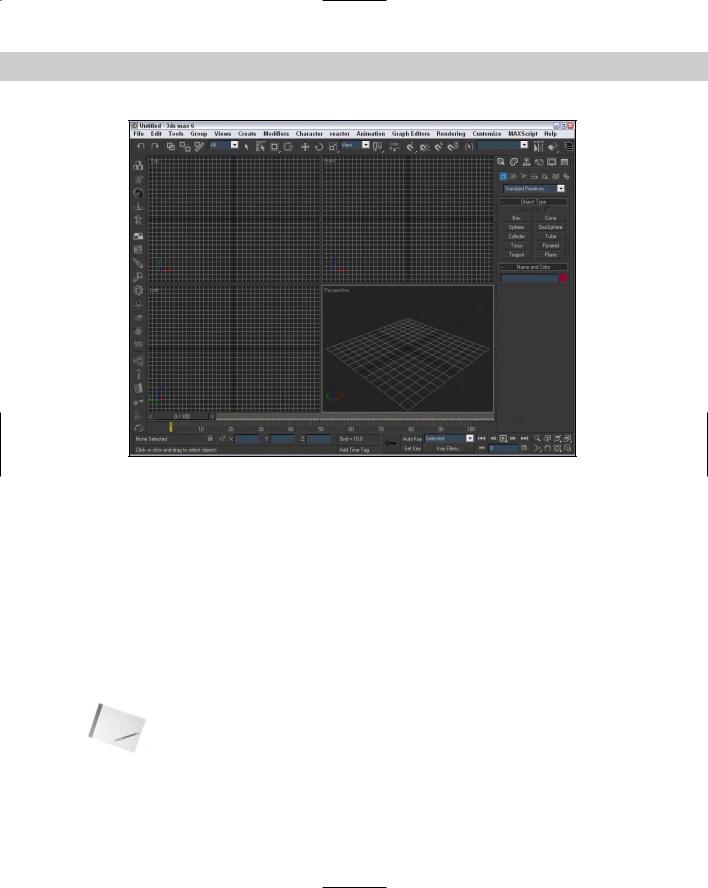
Chapter 4 Customizing the Max Interface and Setting Preferences |
141 |
Figure 4-12: The Discreet-dark interface is one of the preset custom interfaces that you can load.
Tutorial: Saving a custom interface
You can save personalized interfaces for later recall in the 3dsmax\UI directory where Max is installed. To do so, choose Customize Save Custom UI.
To have Max start with your custom interface, follow these steps:
1.Customize your interface by making any desired changes.
2.Choose Customize Save Custom UI Scheme. The Save Custom UI Scheme dialog box opens.
3.Open the UI subdirectory (if you are not already there), select the MaxStart.ui file, and click OK.
4.Click OK to replace the existing file.
Note You can set Max to automatically save your interface changes when exiting. Select the Save UI Configuration on Exit option in the General tab of the Preference Settings dialog box.
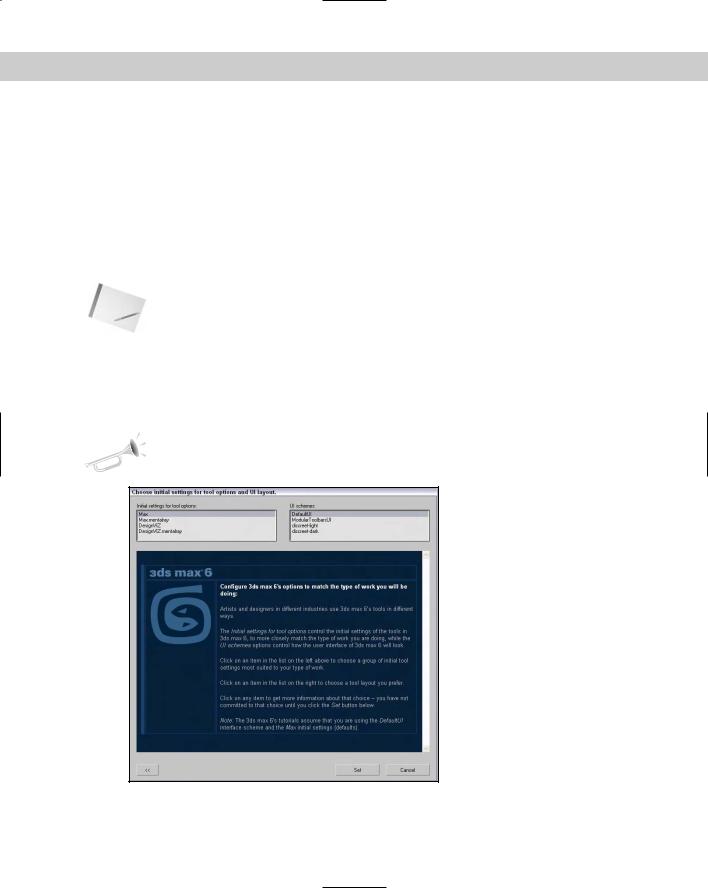
142 Part I Learning the Max Interface
Locking the interface
After you’re comfortable with your interface changes, locking the interface to prevent accidental changes is a good idea. To lock the current interface, choose Customize Lock UI Layout (or press the Alt+0 keyboard shortcut).
Reverting to the startup interface
When you’re first playing around with Max’s customization features, really messing things up can be easy. If you get in a bind, you can reload the default startup interface (MaxStart.ui) with the Customize Revert to Startup UI Layout command. Using the File Reset menu command does not reset changes to the layout.
Note |
If your MaxStart.ui file gets messed up, you can reinstate the original default interface setup |
|
by deleting the MaxStart.ui file before starting Max. |
Switching between default and custom interfaces
The Customize Custom UI and Defaults Switcher menu command opens an interactive window that presents several options for selecting initial settings and interface schemes, as shown in Figure 4-13. At the top of the window, you can select an option and details about the selected option is displayed.
New |
The Settings and Scheme chooser window is new to 3ds max 6. |
Feature |
|
Figure 4-13: This window explains the benefits of the different initial settings and scheme choices.
